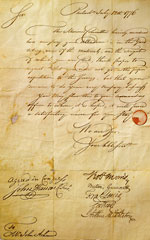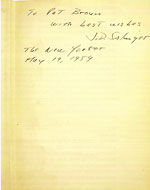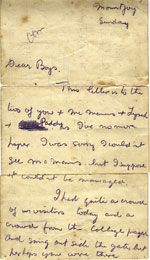Autographs and Photographs: From Button Gwinnett and J. D. Salinger to street photographer Robert Frank
Button Gwinnett, Elusive Signatory to the Declaration of Independence
Document signed by Button Gwinnett on July 12, 1776, $722,500 at Sotheby’s New York on April 14
Eight sales over the next twelve months will disperse the historical Americana collections in the James S. Copley library. The star turn of the first sale was the finest available example of the most sought after, if not the most famous of American signatures—that of the planter and politician who signed the Declaration of Independence on behalf of Georgia.
For those following the well trodden but expensive path of collecting all 56 signers, Button Gwinnett is the big stumbling block. The English-born merchant was killed in a duel at the small town of Thunderbolt, near Savannah, less than a year after signing the historic document. A heated dispute over responsibility for the failure of an expedition against British posts in Florida had led to a duel between Gwinnett and Georgia’s military commander.
Just 51 examples of Button Gwinnett’s signature are recorded and most are simply clipped signatures or attached to routine legal documents. Refining the chase even further, only eight date from 1776, and the autographed document in the Copley library, signed as a member of the Marine Committee of the Continental Congress is as close as one can get to the key date of July 4.
Drawn up by Timothy Mack, scribe of the original engrossed Declaration itself, this letter was addressed to John Ashmead, clerk of the frigate Randolph, then building in the Philadelphia Navy Yard. With conflict imminent, Ashmead had sought permission to rejoin his company of the Quaker Light Infantry before it left for New Jersey, but the committee requested he stay at his post in the shipyard. Their reply also bears the signatures of five other ‘signers,’ but Button Gwinnett is the one that counts.
It was last seen at auction in 1989, when as part of the vast Estelle Doheny library it realised $209,000 at Christie’s New York.
J. D. Salinger—Another Rare ‘Signer’
J. D. Salinger, The Catcher in the Rye, $80,500 at Doyle of New York on April 28
Over the last 30 and more years, just two inscribed copies of J. D. Salinger’s novel have come to auction, so the arrival of a third was always likely to get American collectors very excited.
The dust jacket was poor and lacked much of the spine, but it was a 1951 first with a $3 price tag and, on the rear of the jacket, a photograph of the notoriously reclusive writer who died earlier this year. What really counted was the fact that it was inscribed “To Pat Brown with best wishes J. D. Salinger The New Yorker, May 19 1959.”
It was estimated at a cautious $12,000-15,000, but the price paid was in excess of anything previously seen. In 2004, the copy in the Neville library, which had a better jacket and bore a longer and more affectionate inscription to the radio and television director producer Fletcher Markle (who wanted to film the book) and his wife, the actress Mercedes McCambridge, proved something of a disappointment in selling at just $28,800 at Sotheby’s New York. And for the Markles, the author had even signed as Jerry Salinger!
“Just a Lad of Eighteen Summers”
Kevin Barry’s farewell letter, Euros 87,000 ($118,000) at James Adam & Mealys in Dublin on April 14
These two salerooms get together each year to mount an Irish ‘Independence’ sale, and this year offered a poignant letter from a young man about to meet his end for the cause.
Written in blue prison pencil in his cell on the night before his execution, this remarkably composed letter was one in which Kevin Barry said his farewells to his pals. A medical student at University College, Dublin, he had joined the IRA and taken part in an attack on a military lorry in which three British soldiers were killed. Captured at the scene, Barry was court-martialled and hanged in Mountjoy Jail on the morning of November 1, 1920—the first republican to be executed since the leaders of the Easter Rising of 1916.
“Dear Boys,” wrote Barry, “I had quite a crowd of visitors today and a crowd from the college prayed and sang outside the gates but perhaps you were there. Well boys, we have seen some good times, and I have always considered myself lucky to have such a crowd of pals. It’s the only thing which makes it hard to go, the fact of leaving you chaps and other friends behind. Now I charge you thank anybody you know for me, who has had masses etc. said. Everybody has been awfully decent and I can assure you I appreciate it. Also say just a few more prayers when I go over, and then you can rest. … Your pal, Kevin.”
An anonymous ballad written shortly after the event included the lines:
Just a lad of eighteen summers,
Yet there’s no-one can deny—
As he walked to death that morning
He proudly held his head up high
Barry’s execution led to a swell of support for the Irish independence struggle, both nationally and internationally.








 Ian McKay’s weekly column in Antiques Trade Gazette has been running for more than 30 years.
Ian McKay’s weekly column in Antiques Trade Gazette has been running for more than 30 years.

